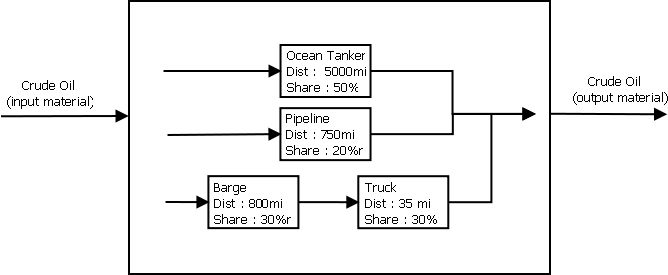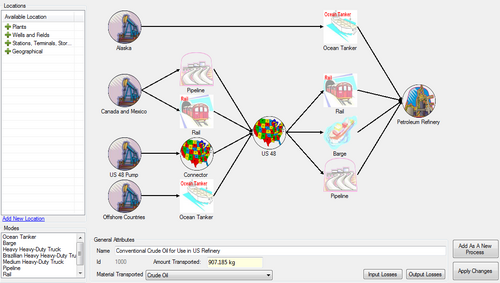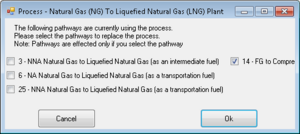Transportation Process
Model
Basically a transportation process describes how a material is transported to one location to another. Typically we have a transportation process between two stationary processes, unless the stationary processes are at the same location.
A transportation process can describe how a material is typically transported from different locations. If the material has been produced overseas, we are going to use an ocean tanker to transport it. If the material is local, we can use ground transportation modes like pipeline or truck.
Inside a transportation process, we define transportation steps. A step consist of a transportation mode, associated to a distance parameter and a share parameter. Above the diagram shows four different steps within the process. The transportation steps can be used in different configurations which might be a sequence of steps, like the barge then the truck, or work in semi-parallel mode like the ocean tanker and the pipeline. The semi-parallel configuration means that the material is coming from different locations, like overseas and Canada, but merge at the same point. For example a refinery can use crude oil coming from many places.
Then we are going to calculate how much energy is needed for each step within the process, and sum them up in order to have the transportation process results. In order to know which materials are used, any steps has a set of fuel shares. In the fuel shares, we might describe which fuels are used to propel the ocean tanker, or what energy is used to run the compressors of the pipeline. The emissions are calculated based on the technologies used by the mode, like a residual oil engine for the ocean tanker, or a electric motor for the pipeline.
There is an analogy which can be made to the stationary process. A stationary process is organized as a tree, where the process is the trunk, branches are the fuels, and leafs are the technologies. In a transportation process, the branches are kind of the technologies ( tanker, pipeline, truck...) and the leafs are the process fuels ( defined by the mode fuel shares ). This is very important because after the processes are broken down into smaller pieces, the same balance algorithm can be used to calculate both of them.
Calculations
Energy Intensity
Ocean Tanker and Barge:
= Energy Consumption in Btu/hphr
= Horse Power
= fuel transported
= process fuel
= constant
= Average Speed (constant)
is calculated as follows:
For the Ocean Tanker :
For the Barge
To calculate ec - energy consumption the following formulas are used:
Ocean Tanker:
Barge:
Truck:
= fuel transported
= process fuel
FuelEconomy = constant
Pipeline:
Given value. There are several fuels which can be used as a process fuel for the Pipeline. However the energy intencity is a function of the type of the fuel:
\begin{itemize}
\item Liquid Fuel
\item Solid Fuel
\item Natural Gas
\item Hydrogen
\end{itemize}
Groups are introduced in greet tatabase in order to sort fuels by types and by any other features.
Rail:
Given Value. Process fuel for Rail is Diesel and ei is constant for any fuel transported.
Editor
To access the transportation process editor select "Data Editor" from the top of the main form and then click "Processes". Next either select "Add Transportation Process" to add a new process or "Modify Existing Process" to select an existing transportation process.
The first step in creating a new transportation process is to define which Resource will be transported. You can do this via the drop down menu at the bottom of the editor. Directly above this combo box you can define the amount of the Resource that will be transported. If creating a new process give the process a name and enter how much of the selected material is to be transported in the process.
After defining the basic parameters the transportation process can be built by dragging locations and modes from the lists on the left to the main panel on the right. To be considered a valid process it must at least have a starting location, an ending location, and a mode to transport the resource between the two. Once a location and a mode have been dropped onto the panel they can be connected by hovering the mouse over the right side of the location or mode image and dragging the arrow to the left side of the next location or mode. A location represents a geographical starting or ending point for which the resource needs to be transported from or to. A mode represents a means of transporting the selected resource between locations. The image on the right shows a completed process in the transportation process editor.
To remove a connection, mode, or location right click it and select the delete option.
Losses that are included in the efficiency calculation can be added by clicking edit input losses and adding an appropriate loss and output losses for losses not accounted in the efficiency.
Other guidelines: In order to be valid, the transportation structure must consist of at least one valid step (an origin, mode, destination set) and only one end destination is valid. In addition, invalid connections are prevented such as connecting two origins to a single mode or connecting a mode to multiple destinations.
Saving
After you are done creating/editing the transportation process you can save it. If there are any errors with the process they will be displayed in a message before the process may be saved. To save the process as a new process click the "Add As A New Process" button will create a new process with the selected parameters and structure. If the process is already in use by some pathways a dialog will be displayed to allow replacing that process with the new process in the selected pathways.
To save an existing pathway click the "Apply Changes" button and the changes will be reflected in the existing process.

















